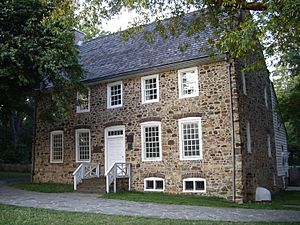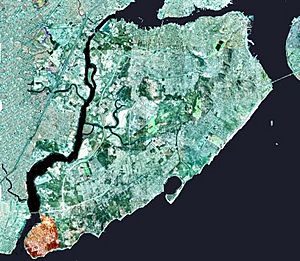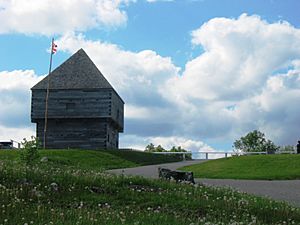Christopher Billop facts for kids
Quick facts for kids
Christopher Billopp
|
|
|---|---|

"The Conference House" Christopher Billopp’s home on Staten Island
|
|
| Personal details | |
| Born | c. 1738 |
| Died | March 29, 1827 (aged 88–89) |
Christopher Billopp (around 1738 – March 29, 1827) was a British Loyalist during the American Revolution. Loyalists were people who stayed loyal to the British Crown during the war. Because he led a group of soldiers who supported the British, he was sometimes called the "Tory Colonel." After the American Revolution ended, he moved to New Brunswick, Canada, joining many other Loyalists. There, he became a politician and represented the city of Saint John in the first New Brunswick government.
Contents
Christopher Billopp's Story
Christopher Billopp was born on Staten Island in New York. He was the oldest of eight children. His family had a long history on Staten Island. His great-grandfather, also named Christopher Billopp, was a British sea captain. He received a large piece of land, about 932 acres (3.77 km2), on the southern tip of Staten Island. There, he built a stone house called "Bentley Manor."
Fighting in the American Revolution
During the American Revolution, Christopher Billopp served as a colonel in the Loyalist forces. He led a group called the Billopp's Corps of Staten Island Militia. This group was formed on July 6, 1776, after the Declaration of Independence was announced. About 500 men gathered in Richmondtown to support the British. Interestingly, Christopher's brother, Thomas Farmar, fought against the British Crown.
Billopp was captured by American Patriots two times. One time was on June 23, 1779, when Patriots rowed across the Arthur Kill from Perth Amboy, New Jersey. He was held as a prisoner of war in a jail in Burlington County, New Jersey. He was chained to the floor and given only bread and water. This harsh treatment was meant as a way to get back at the British for how they treated American prisoners.
Another prisoner in the same jail was John Graves Simcoe, a British officer. Simcoe had led a raid into New Jersey from "Billop's Point," which was Christopher Billopp's land. Simcoe was also captured during this raid. Billopp was finally released in a prisoner exchange after Christmas.
In October 1779, New York State declared Billopp a Loyalist "felon." This meant he could be sent away, and all his property could be taken. However, Staten Island was controlled by the British at the time, so this didn't happen right away. Still, Billopp wisely started selling his land in 1780, often for less than it was worth.
When the war ended, Christopher Billopp left the newly formed United States. He moved to the British colony of Nova Scotia, and later to New Brunswick when it became a separate colony.
Life in New Brunswick
In 1783, Billopp moved to Parrtown in New Brunswick with his father-in-law, Benjamin Seaman, who was also a Loyalist. Parrtown and Carleton were two towns started by Loyalists near Fort Howe. These two towns later joined together to form the city of Saint John. Even Benedict Arnold, a famous American general who switched sides to become a Loyalist, lived in Saint John for a few years.
Christopher Billopp served in the New Brunswick Assembly, which was like their local government. In 1796, King George III appointed him to the council, a higher political group. In 1823, he was asked to become the temporary leader of New Brunswick after the Lieutenant-Governor died. However, he refused to travel to Fredericton to take the oath of office. Another person, Ward Chipman, took the job instead.
His Family
Christopher Billopp was married twice. His first wife was Francis Willett, and they had several children:
- Thomas Billopp: He moved to New York City and started a business. He later joined an expedition to Venezuela in 1806, trying to start a revolution against Spanish rule. He was captured and sadly hanged in Venezuela. His daughter, Frances, married William Edward Wyatt, and the famous actress Jane Wyatt is one of their descendants.
- John Willett Billopp: He was born on Staten Island and died in New York City in 1798 during a yellow fever outbreak.
- Elizabeth
- Sarah
- Catherine
His second wife was Jane Seaman. They also had several children:
- Louisa Billopp: She married John Wallace, a customs officer. A portrait of Louisa was painted around 1816 and is now owned by the Canadian government.
- Mary Billopp: She became the second wife of Rev. Archdeacon Willis and died in Nova Scotia.
- Jane Billopp: She married William Black, who was also a member of the government in New Brunswick.
- Anne
- Katherine
The Famous Peace Meeting
Christopher Billopp's old family home in New York, Bentley Manor, was the site of an important but unsuccessful peace conference on September 11, 1776. This meeting was an attempt to stop the American Revolution. Important American figures like John Adams, Benjamin Franklin, and Edward Rutledge met with the British representative, Lord Howe. The meeting didn't lead to peace, but the house is now a United States National Historic Landmark and is known as the Conference House.
A Ghost Story?
After his last release from being a prisoner, Billopp returned to his manor house. Legend says he believed a 15-year-old servant girl had signaled his location to the Patriots. She supposedly held a candle by a second-floor window, which could be seen by Patriots in Perth Amboy. The story goes that Billopp caught her doing this and, in a fit of anger, threw her down a flight of stairs, killing her. People say that his ghost and the ghost of the girl still haunt the Conference House, reliving their deadly struggle.
His Gravestone
Christopher Billopp's gravestone in New Brunswick tells part of his story. It says he was a member of the King's council and that his strong loyalty to the British during the American rebellion forced him to leave his family property on Staten Island without being paid for it. He moved to New Brunswick, where he was respected by everyone. He died on March 28, 1827, when he was 90 years old.
|




